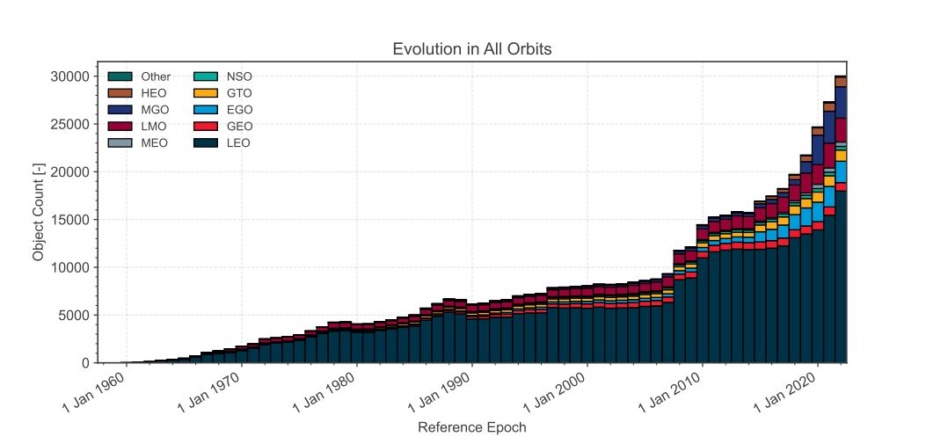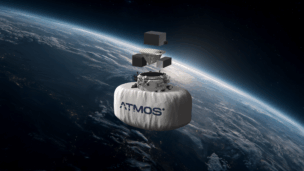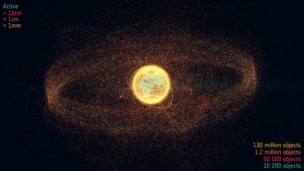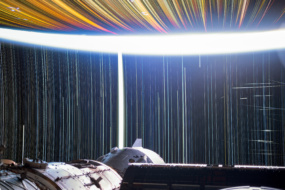When humanity was just beginning space launches 60 years ago, it seemed as if nothing could stand in the way of our inevitable push into the cosmos. Now, a booming young commercial space industry is brushing up against a consequence of this frontier mindset, and a problem of our own making: debris.
Orbiting several hundred miles above our heads is a field of metal, the remnants of satellite launches over the past several decades. Many of these objects are online and operational, but more are not. The growing corpus of junk poses the risk of cutting off our access to key orbits for decades.
That’s the worst-case, sky-is-falling scenario. In the meantime, the accelerated pace of launch over the last decade has increased the constant threat of satellite collisions in orbit. The expected boom in launch capacity and tens of thousands of additional licensed satellites are bound to make the congestion issue worse.
And here’s the kicker: there’s little accountability for satellite operators to maintain a safe, operable orbital environment for current space actors and future generations.
Orbital debris is frequently referred to as a tragedy of the commons—and that it is. But it’s also a product of short-termism, space races, and governments’ reticence to acknowledge their countries’ impact on Earth’s orbital environment.
State of the orbital environment
The term “orbital debris” refers to anything in space that isn’t being used for a practical purpose, whether that’s defunct satellites, spent rocket bodies, broken pieces of satellites, or shards of material as small as a grain of sand.
Active satellites and spacecraft aren’t considered debris. On the contrary, at least in the short term, they’re the assets that commercial space operators and governments alike are most keen to safeguard and protect.
Pieces of debris larger than 10cm are trackable from ground telescopes on Earth. Between ~1cm and 10cm, there’s a danger zone of objects that are harder to track, but could still cause some serious damage to a spacecraft if they were to collide. The DoD’s Space Surveillance Network can track objects in low-Earth orbit (LEO) down to 5cm, and currently tracks about 27,000 of these objects. Smaller objects will eventually be trackable via the DoD’s ground-based Space Fence and other developing technologies. Then, we enter the realm of currently untraceable objects: <1cm objects. NASA estimates that there are over 100 million pieces of these satellite shards and flecks of paint in Earth’s orbit right now.
Objects orbiting in low-Earth orbit (LEO), or anything less than 2000km from Earth, are intended to reenter the atmosphere and burn up after a certain amount of time. The time to atmospheric reentry varies based on the size, shape, and, importantly, altitude of the orbiting object. A piece of debris orbiting at 300km may deorbit naturally due to atmospheric drag after only a few weeks. A good rule of thumb is that for every 100km increase in altitude, it will take ~10 times longer to naturally deorbit. At 700km, it could take a thousand years to deorbit without any intervention.
Useful taxonomy: A 2021 McKinsey report by analysts Chris Daehnick and Jess Harrington suggests a practical categorization of space objects, falling into four categories:
- Active satellites
- Uncontrollable dead satellites and other large objects, i.e. spent rocket stages
- Small, trackable debris
- Untrackable debris
A large satellite left unattended in LEO poses clear risks to operational satellites, but the mass of tiny, untrackable debris is dangerous as well.
“There’s a huge amount of kinetic energy,” John Janka, Viasat’s head of government affairs, told Payload. “These things are moving at 17,000 miles an hour.” A fleck of paint from a spent rocket traveling at these high speeds can still wreak havoc on an operational satellite—or prick holes in the spacesuits of astronauts on spacewalks—if a collision occurs.
In the 1cm–10cm regime, objects “are still a threat to satellite operators because they carry a lot of energy. Just a small aluminum cube can carry the energy of a hand grenade,” Stefan Frey, CEO of space situational awareness (SSA) startup Vyoma, told Payload.
Right now, before a company launches a satellite to orbit from the US, it must perform a collision risk analysis. Operators’ analyses must show that the risk of collision with another satellite is lower than 1/1000. But in an orbital environment containing tens of thousands of satellites, each with an initial collision risk of ~1/1000, back-of-the-napkin math suggests some collisions are bound to occur. What then?
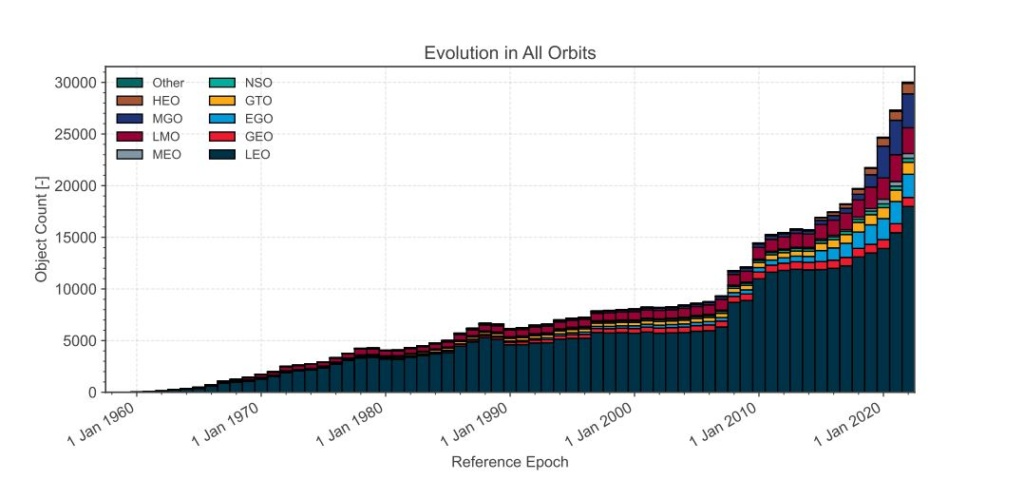
The second-order effects
Debris could pose an existential threat to the commercial space industry and government agencies alike. The immediate threat is that a piece of debris could strike a satellite operating in orbit, rendering it unusable and dashing the investment from its earthly operator. The long-term, extrapolated threat: loss of access to space.
NASA scientist Donald Kessler first laid out a now-eponymous scenario in which debris-generating collisions create a cascading chain of events, eventually creating catastrophic consequences in space.
The theory has come to be known as the Kessler Effect. In his seminal and prescient 1978 paper, Kessler proposes a straightforward argument:
- More satellites are launched into orbit.
- As the number of satellites increases, the likelihood of collisions rises.
- Collisions occur, producing ever-larger debris clouds.
- Rinse and repeat, on a greater and greater scale.
“It’s easy to understand,” said Janka. “You imagine in New York, if there’s one beaten up cab going down the street, well, it breaks down, maybe there’s a risk of a collision, but it’s only one. But if the entire fleet is broken down, there’s a greater chance of collision because each of them adds up.”
Kessler warned that a human-created debris belt around Earth would in turn endanger future human spaceflight and non-crewed launches.
The problem gets even more complex when factoring in the increased rate of human spaceflight —and projections for much more activity in the coming decade and beyond. Orbital space tourism is becoming a nascent reality, as governments’ manifests also grow. And there are plans for more free-flying stations in the works. Not all of these may be completed, but at least a handful of commercial and government-run stations are destined for long-term domicile within LEO.
Unpredictable and uncontrollable debris conditions could spell disaster for humans in similar orbits. Last year, astronauts aboard the ISS were instructed to begin safe-haven procedures and shelter in certain regions of the craft due to a debris field that came from a Russian ASAT (anti-satellite) test on Kosmos-1408, an old Soviet satellite. Everyone was fine—but without adequate preparation and, importantly, enforced international standards for debris creation and mitigation, that may not always be the case.
“Obviously, well, we can survive without [satellite services], but the environment that we’ve created for ourselves and that we’re creating for our kids, it will be reliant on [space-based services],” Chris Blackerby, COO of prominent orbital debris removal startup Astroscale, told Payload.
“[Space] makes our lives better,” Blackerby said. “It gives us easier and faster access to information. It provides for communities that don’t necessarily have the capability to get wired connectivity into their areas to be able to do so. We see it being beneficial in understanding our climate.” Without access to space and to satellite data, all these things are at risk.
The million (billion?) dollar question…
…Who’s responsible?
Then, there’s a host of follow-on questions:
- Should companies be responsible for installing propulsion systems that can deorbit their own satellites when they stop working?
- Should companies operating satellites without propulsion systems be required to employ removal services?
- Should this be mandated by the government, or driven by market forces that incentivize companies to maintain an operable orbital environment?
- Should governments take the issue on themselves, and pay for waste removal services?
Frustratingly, there’s no silver bullet, nor true historical precedent. Most proposals, though, involve governments shouldering some responsibility for orbital debris mitigation.
“All the responsibility falls on governments,” Moriba Jah, astrodynamicist, space environmentalist, and chief science officer of space traffic management startup Privateer told Payload in November. “When it comes to liabilities and damages, or authorization and providing supervision, that falls on states party to a treaty or agreement. Governments are in complete power.”
To be sure, some government support is needed in the near-term to ensure that commercial space companies act in the public interest on orbit. Unlike Earth, space can’t be divided up with national borders, with each country subject to its own laws and regulations. A certain level of international cooperation and buy-in on norms in space will be table stakes. Without a legal incentive to remove defunct satellites from orbit at the end of their lifetimes, we’re left only with the financial incentive: that cluttering up LEO or other key orbits with junk means it’s a riskier investment to put up or operate satellites.
The international cooperation issues at play are a textbook case study from Foreign Policy 101. No major spacefaring nation wants to be the first to handcuff its domestic space sector with more stringent licensing procedures or launch restrictions.
As more countries put their sovereign assets on-orbit, they may be less inclined to accede to multilateral restrictions from the powers that be. The thought process: A handful of major space programs have been able to launch unimpeded for decades, and they’re responsible for the lion’s share of space junk. Why shouldn’t we, too, be able to enjoy the same privileges?
No one wants to be the first to put stringent regulations on debris creation and risk crushing their domestic space sector, especially if other countries are to race ahead with little regard for the orbital commons. Global norms, instituted more or less synchronously, are needed before enforceable regulations can be put in motion.
Right now, the technology needed to deorbit large pieces of debris—or shuttle them to orbital graveyards—is bleeding-edge and far from commercially viable. Requiring space operators to employ mechanisms that either don’t exist or haven’t been proven out is, to say the least, a hard sell.
Luc Piguet, CEO of debris removal and on-orbit servicing startup ClearSpace, put the problem in Earth terms. Down on Earth, if you’re driving a reliable car on the road and it breaks down in the takeover lane, you have a few options: repair the car or tow it away. Either way, the driver is responsible for ensuring the car gets off the road, and there are consequences if they abandon the car there.
If, instead of getting your broken-down car off the road, you “go buy another car and continue driving, you would have committed a fault, because you could have paid for a tow truck to remove it. It’s your responsibility to make sure that you take all the measures possible to avoid risk for the other drivers on the motorway,” said Piguet. “The reason why that’s not the case in space is because there’s no tow truck.” How can a launching state require operators to use on-orbit “tow trucks” that don’t exist?
It’s easier to ensure that debris doesn’t linger in space in the first place. While nations can’t mandate that companies use unproven and expensive debris removal services, there is room for improvement in setting rules of the road for safely tracking, maneuvering, and eventually deorbiting new satellites.
Today’s regs and rules of the road
Legally, there are few regulations that satellite operators must abide by before getting to space. The US government has ODMSP (Orbital Debris Mitigation Standard Practices), which provide a framework for how agencies should approach debris creation. Before launching, operators have to provide the FCC with collision risk analysis, and they are required to deorbit LEO satellites after 25 years—too long a timeframe, critics say. ESA has the same recommended deorbit timeline. Satellites that won’t naturally deorbit within that time must be boosted into a different orbit, out of the way. Besides those, decisions for what to do about the debris environment remain at the whim of operators.
“There is so far no one that actually forces you to clean up after yourself,” said Dr. Luisa Buinhas, founder of Vyoma. “There are a couple of guidelines that people need to adhere to. Some of the countries adhere, some of the players do not adhere, but even if you do not, it’s not like there are consequences. And this is problematic because this leaves the burden for whoever comes after you.”
There are a few guidelines that companies angling to launch satellites should abide by. For the most part, they’re less solid, enforceable regulatory frameworks than they are suggested best practices, coming from government agencies, international consortia and industry groups with a vested interest in maintaining the safety and operability of the orbital environment.
When operating at higher LEO orbits, operators are required to have onboard propulsion systems for deorbiting, said Iridium VP of space and ground services, Walt Everetts. Iridium’s constellation is in a ~780km orbit, and the satellites would not naturally deorbit within 25 years due to atmospheric drag. Recently, the company replaced its Block 1 constellation with a batch of new satellites, and deorbiting the old birds took about 19 days per satellite to complete.
Iridium and a handful of other operators also work closely with the Combined Space Operations Center (CSpOC), an office within the US Air Force that works to coordinate government and commercial responses to changes or threats in the orbital environment. Within CSpOC, the Commercial Integration Cell (CIC) works with commercial operators to coordinate responses to conjunction data messages and expedite data sharing between major players.
The UN maintains its own list of debris mitigation guidelines, codified by the General Assembly in 2007. The guidelines urge member states to limit debris creation, potential for break-ups, collision probability, intentional destruction, stored energy at end-of-life, and the long-term presence of spacecraft in both LEO and GEO. Member states are responsible for voluntarily following these guidelines.
ESA follows debris mitigation standards set by the International Organization for Standardization (ISO), although these standards are also nonbinding.
The Consortium for Execution of Rendezvous and Servicing Operations (CONFERS), an industry group dedicated to creating international guidelines for on-orbit satellite servicing and close approaches, maintains a list of recommended best practices that it makes freely available online. Those guidelines emphasize the importance of maintaining shared standards for spacecraft design, information sharing, and satellite licensing across national boundaries.
“We need to move toward both technical and operational standards that are better shared and understood and accepted across the world,” said Blackerby, who also chairs CONFERS. “It’s difficult, and it takes time.”
That’s not to say that debris mitigation strategies aren’t in the conversation at a governmental or international level. Last month, the US government announced a self-imposed ban on destructive, direct-ascent ASAT (or anti-satellite) tests.
Auspicious timing? The US’ anti-ASAT declaration arrived just in time for a planned UN discussion that began May 9, 2022 about creating norms for behavior in space. The UN’s Open-Ended Working Group will discuss the ASAT ban and other proposed norms for responsible spacefaring at four meetings over two years. (Sigh.)
